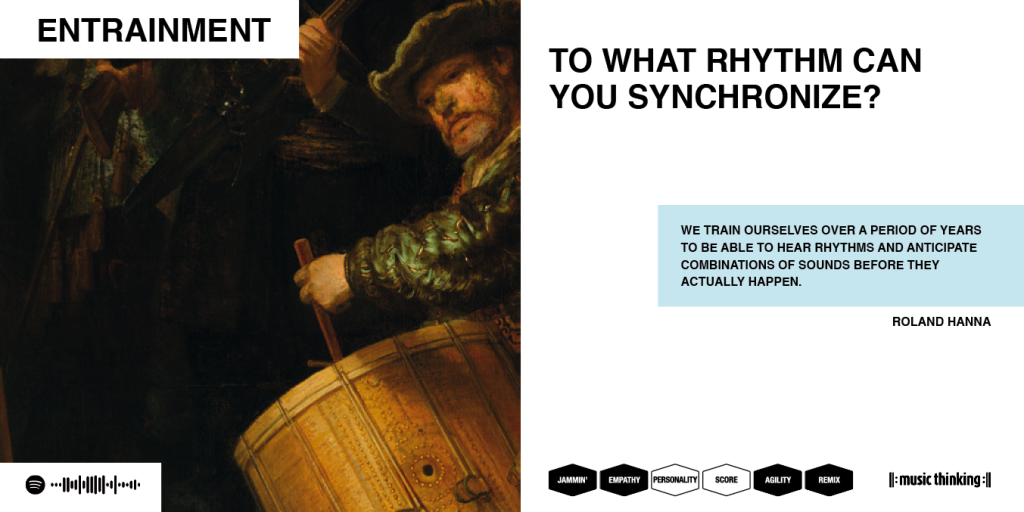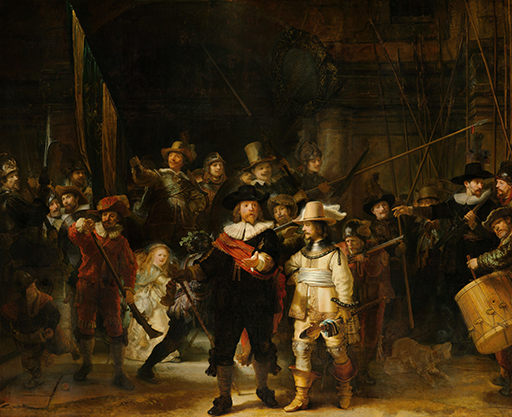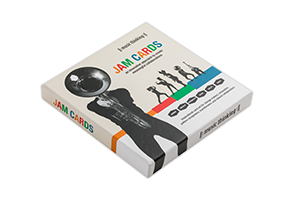
There are many books written about team building. Amazon lists more than 8.000 titles and a quick search on google results in 4.880.000.000 links, as of today. There is one aspect of interacting teams that I find interesting. It is the moment when things come together when we are in sync or in flow (like Mihaly Csikszentmihalyi calls it). I call this entrainment.
Entrainment is a difficult word and not used in daily conversation, that’s a pity because it is used in different references: the practice of entraining one’s brainwaves to a desired frequency, the synchronization of organisms to an external rhythm, the alignment of a circadian system’s period and phase to the period and phase of an external rhythm, the process whereby two interacting oscillating systems assume the same period and so on.
The Entrainment Card

The essence of the entrainment card is how can we reach entrainment as a duo, trio, or a bigger group. So as a team or organisation we could ask questions like: What does it need from every individual to act as one? To what theme, rhythm or signal can we have entrainment? What are the moments when you recognize that you are in entrainment with others and What behaviour can lead to entrainment? And most of all: How can we encourage or facilitate everyone to do this?
The picture

The Night Watch is one of the most famous Dutch Golden Age paintings. Militia Company of District II under the Command of Captain Frans Banninck Cocq, also known as The Shooting Company of Frans Banning Cocq and Willem van Ruytenburch, but commonly referred to as The Night Watch (Dutch: De Nachtwacht, 1642 painting by Rembrandt van Rijn.)
There is so much written about this phenomenal painting, but I want to lead your attention to the right side of the painting, where the drummer is only partly in the picture. What intrigues me is that he is in total sync with the two protagonists in the middle of the painting and they are in sync of the rhythm from the drummer. You see in the concentration in the face of the drummer that he is focussed in being in sync, helping everyone to come together. And the protagonists hear the rhythm and act upon it.
The quote
We train ourselves over a period of years to be able to hear rhythms and anticipate combinations of sounds before they actually happen.
American jazz pianist Roland Hanna describing an essential capability in improvisation and playing jazz. It is more than just being in sync in playing together like in an orchestra, it is being in sync without knowing beforehand what will come but developing, instant composing, anticipating and co-creating.
The music
Poème Symphonique is a composition by György Ligeti for one hundred mechanical metronomes. The piece is written for ten “performers”, each one responsible for ten of the hundred metronomes. The metronomes are set up on the performance platform, and they are then all wound to their maximum extent and set to different speeds. Once they are all fully wound, there is a silence of two to six minutes, depending on the conductor; then, at the conductor’s signal, all of the metronomes are started as simultaneously as possible.
The beautiful sound of the different tempi gives the impression of rain. The piece typically ends with just one metronome ticking alone for a few beats. The metronomes are not in entrainment.
Here is an experimental video that ‘solves the problem of entrainment with the metronomes on different speed’.
Five metronomes are set to 176 bpm and placed on a Foamboard. When empty cans are placed underneath, the board is free to move from side to side and the metronomes are able to influence each other into synchronization.
When the cans are removed the metronomes are no longer physically coupled and some of them begin to fall out of step again.
The cues
The JAMMIN’ cue connects with the EMPATHY cue, this means we have to be creative and also have a feel for the other. We have to sense what the other is doing, needing, wanting and hopefully the other is doing the same. This means entrainment is not only done by one person, but it also needs at least two or more. If this works together we have the base for AGILITY, because like Roland Hanna is saying there is anticipation ‘before it really happens’. The REMIX is the result that shows this meaningful interaction.
Some inspirational links:
Rijksmuseum Announces Restoration of the Night Watch and Invites the Public to Watch
Van Morrison, That’s entrainment
Flow the secret to happiness by Mihaly Csikszentmihalyi
Music Thinking Jam Cards
 An inspirational card set for change makers, pattern recognisers, innovators, transformers and natural collaborators. The Jam Cards consist of 38 inspiration cards and six cue cards. All inspiration cards have a keyword, a visual and a sonic trigger, a trigger question, an inspirational quote, and six cues that connect with the Music Thinking Framework. You can use the cards from a strategic point of view, knowing what you want or need and a serendipity approach open to everything that will happen. ‘Music Thinking’ lets people work and play together in a new way with inspirations from the rich world of music.
An inspirational card set for change makers, pattern recognisers, innovators, transformers and natural collaborators. The Jam Cards consist of 38 inspiration cards and six cue cards. All inspiration cards have a keyword, a visual and a sonic trigger, a trigger question, an inspirational quote, and six cues that connect with the Music Thinking Framework. You can use the cards from a strategic point of view, knowing what you want or need and a serendipity approach open to everything that will happen. ‘Music Thinking’ lets people work and play together in a new way with inspirations from the rich world of music.
Order the Music Thinking Jam Cards
You can order the jam cards via your local bookstore (worldwide) and have a nice chat with the people there and try the cards right away, or just buy them directly at BIS Publishers. Yes, you can also find them at Amazon.com, Amazon.de, and Bol.com
